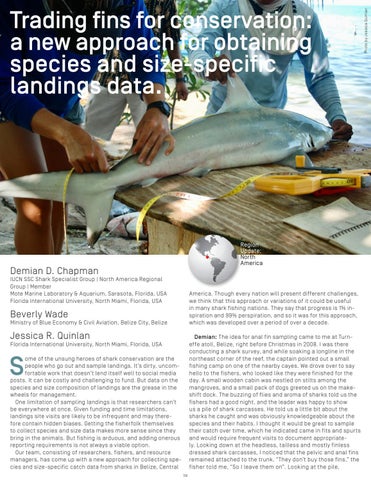Region Update: North America
Demian D. Chapman IUCN SSC Shark Specialist Group | North America Regional Group | Member Mote Marine Laboratory & Aquarium, Sarasota, Florida, USA Florida International University, North Miami, Florida, USA
America. Though every nation will present different challenges, we think that this approach or variations of it could be useful in many shark fishing nations. They say that progress is 1% inspiration and 99% perspiration, and so it was for this approach, which was developed over a period of over a decade.
Beverly Wade Ministry of Blue Economy & Civil Aviation, Belize City, Belize
Jessica R. Quinlan
Demian: The idea for anal fin sampling came to me at Turneffe atoll, Belize, right before Christmas in 2008. I was there conducting a shark survey, and while soaking a longline in the northeast corner of the reef, the captain pointed out a small fishing camp on one of the nearby cayes. We drove over to say hello to the fishers, who looked like they were finished for the day. A small wooden cabin was nestled on stilts among the mangroves, and a small pack of dogs greeted us on the makeshift dock. The buzzing of flies and aroma of sharks told us the fishers had a good night, and the leader was happy to show us a pile of shark carcasses. He told us a little bit about the sharks he caught and was obviously knowledgeable about the species and their habits. I thought it would be great to sample their catch over time, which he indicated came in fits and spurts and would require frequent visits to document appropriately. Looking down at the headless, tailless and mostly finless dressed shark carcasses, I noticed that the pelvic and anal fins remained attached to the trunk. “They don’t buy those fins,” the fisher told me, “So I leave them on”. Looking at the pile,
Florida International University, North Miami, Florida, USA
S
ome of the unsung heroes of shark conservation are the people who go out and sample landings. It’s dirty, uncomfortable work that doesn’t lend itself well to social media posts. It can be costly and challenging to fund. But data on the species and size composition of landings are the grease in the wheels for management. One limitation of sampling landings is that researchers can’t be everywhere at once. Given funding and time limitations, landings site visits are likely to be infrequent and may therefore contain hidden biases. Getting the fisherfolk themselves to collect species and size data makes more sense since they bring in the animals. But fishing is arduous, and adding onerous reporting requirements is not always a viable option. Our team, consisting of researchers, fishers, and resource managers, has come up with a new approach for collecting species and size-specific catch data from sharks in Belize, Central 58
Photo by Jessica Quinlan
Trading fins for conservation: a new approach for obtaining species and size-specific landings data.



















